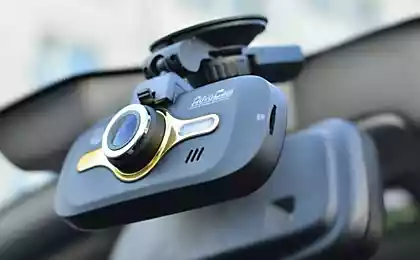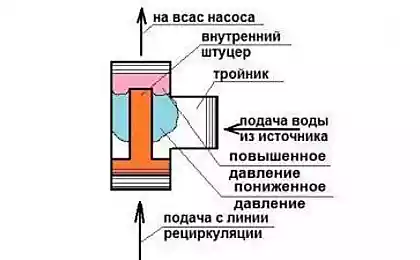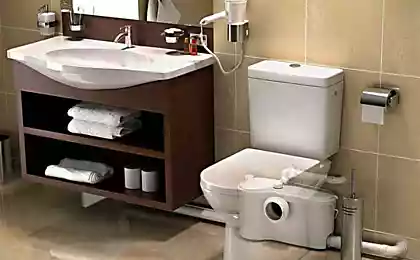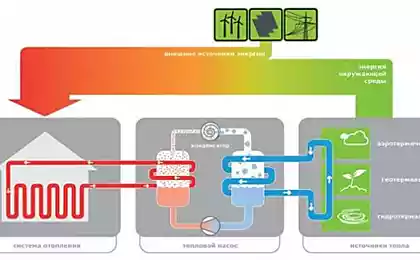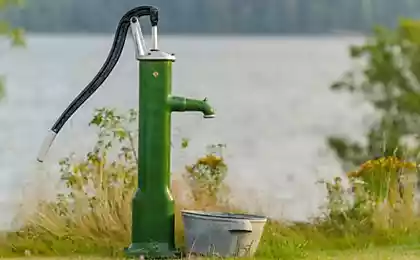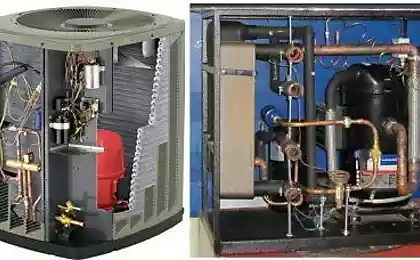795
How to choose a pump for Sewerage in private house
Flowing sewage in a private home to arrange is not always possible. Then to remove fecal waste water from the cottage you have to put sewage pumps, creating a system of compulsory evacuation. There are several varieties of them with different features of installation and operation. Plus on sale you can find a huge variety of models of these devices.
The hydraulic pump in a forced sewer system
To correctly select a pump, you need to understand in all its modifications and to consider many factors.
Most sewers are designed so that the water in it was moving by gravity. But not always a local septic tank or entry into the centralized sewage system is located below the sewer piping and all plumbing devices in the house. And up, the waste water itself can not rise, it is necessary to “force” her pump.
Pumping equipment is when because of terrain or other characteristics of surrounding area outside drainage pipe does not work to put the desired slant. It is also possible with the completion or remodeling of the building. Changes the configuration of the inner pipelines and the amount of waste, independently of the second can not be removed from residential buildings.

The task of the pump forced sanitation to pump out the wastewater and to encourage them to move to a street collector, which is above the cumulative or treatment plant
The most popular variant of the device of the sewer with forced pumping of wastewater provides a device in the basement of the cottage of intermediate storage. As it is filling to the brim the pump is activated, pumping out liquid on the street for further treatment or export. But you can set up a compact pumping unit, included only when the sink drains. However, when it breaks the house will actually remain without sanitation.
Compared to gravity system pressure pumps provides a number of advantages:
Reduced frequency of cleaning of pipelines, as intense movement of wastewater contributes to their self-cleaning.
Sanitary and household appliances with connection to the sewage system is already can be put anywhere without regard for the formation of the slope in the direction of release of sewer, and then drive, or septic tank.
According to the technical regulations (SNiP No. 2.04.03-85), the smallest diameter pipe outside the mainline pressure sewer network was adopted by 150 mm, when arranged obsessively effluent discharge. This network transporting storm water run-off together with household black and grey. Domestic gravity fed systems arranged from the Troyes of the same size.
If human waste water are discharged separately, the diameter of the pipeline is taken is filled to 0.7 of its maximum height. This distance is necessary for ventilation and the possibility of the withdrawal of an unpleasant and explosive gazoobrazovania. The size of the sewer must be considered when choosing a pump to accurately select the unit for the upcoming load.
The forced system is volatile, and costs a lot of money, rather than gravity. If the family is small, the drive is filled immediately, sewage pump could be sufficient from time to time. But for large volume of waste water pumping equipment needs to work almost constantly. In this case, when a power outage can cause serious problems.
A large part of the cost to repair cannot recapture due to the use of cheaper and thin tubes and reduce the cost of their installation. But after the installation of this equipment requires constant maintenance, which requires some money. And if we add another source of power in case of an accident at the power grids, the gain is obtained is zero.

For the device forced the sewer system of a small private house or garden, diverting the mixture of black and grey wastewater, suitable for holding the pump. He will cope with pumping water combined sewer
If it is possible to do with gravity sewer option, you should do it. Pressure system with sewage pump for viscous and contaminated liquids should be chosen only as a last resort. And special attention should be paid to the proper selection of pumping equipment.
Types of pumps for pressure sewer
The most important thing in the selection of pumping equipment for pumping of sewage is clearly separate it from the drainage and water lifting for drinking wells of varieties of these devices. The last two options are exclusively designed for pumping clean or with a fine mist of water. Ingestion of more solid faeces or garbage, they simply break.

Lineup fecal pumps is quite extensive, but the diversity of this equipment can be divided into three classes: submersible, semi-submersible and external
Special sewage pump designed specifically for pumping sewage with all the household waste that fall to the drain from sinks, toilets, dishwashers and washing machines. The most optimal choice here is the pumping equipment with the chopper that grinds all waste before it goes inside the pump drains the unit.
In General, faecal pumps are used for:
Type No. 1: Submersible device
This kind of pumps are all immersed directly in the sewers. All the elements of their design are made of stainless steel or of cast iron to get in contact with the active and aggressive environment does not emerge immediately from the system.

Submersible sewage pump is installed on the tank bottom, or suspended just above him on the rope
Usually, this pumping equipment is operated automatically. When filling the tank drains with them rises the float which at a certain level of liquid includes the installation of pumping. As soon as the container is emptied, the pump float switch is turned off. Work “dry” at the same time is practically impossible.
Submersible models are preferred due to their high performance and equipment of the chipper. Last macerator grinds waste to any large size that do not pose a threat to pumping equipment. Almost all sewage submersible pumps come with a built-in grinder, rotary knives which can easily cope with paper, fibrous items and solids.
Type No. 2: Surface model
Surface pumps for pumping sewage are installed next to the manifold, collect and redirect runoff, or most convenient to place it into the observation well. This so-called dry cut. They are often also referred to as pumping units forced the sewer system due to the presence of several collect together the individual parts.
Polluted runoff in this case are absorbed via connected to the pump unit hose that goes down to the bottom of the tank. If you choose this model, it is necessary special attention should be paid to the parameters of the suction depth specified by the manufacturer. Usually up to 8-10 meters deep, he simply cannot lift drains out of the reservoir. This should take into account not only the height of the receptacle, and the distance from it to the pump.
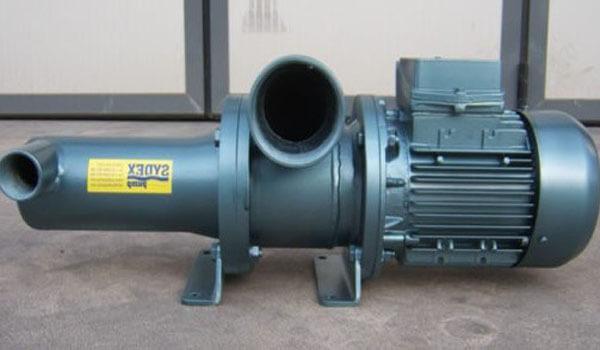
Surface pumping equipment is easier to service, it can be quickly dismantled and washed in the utility room
Low-power surface pump to operate in forced sanitation is a compact unit that is simply mounted near the drive drains. Installation of more powerful models are produced on a specially prepared place with reliable fixation of the device to the floor.
It is extremely important when installing the outdoor pump to worry about its protection from moisture. In contrast to the submersible analogue it is fundamentally not designed to work in a wet environment. His case has minimal protection from water, in contact with which the inside of the closure may occur.
The surface pump is inexpensive and simple to operate, but enough of Shumen. For installation in heated basement or utility room it is better to take it. However, if you turn on the equipment it will be necessary only from time to time to pump the septic tank, it is better to prefer submerged.
Type No. 3: the semi-Submersible installation
These models are a kind of intermediate option between the submersible and the external view of the pump equipment. They have the motor installed next to the container above the water and the working chamber is immersed in the sewage. Between these two parts of a single installation contact a rotating shaft.
Installation of submersible pump can be done on:

Due to the design features of submersible pumps are rarely used in a domestic environment, it is more a variant for industrial applications and large pumping stations
Type # 4: Small units for pumping drains from the plumbing
Under the sewer pump to toilet or basin means small machines that are installed near the fixtures. Effluent from the first last fall in a small tank, and it is discharged into the General sewer system.
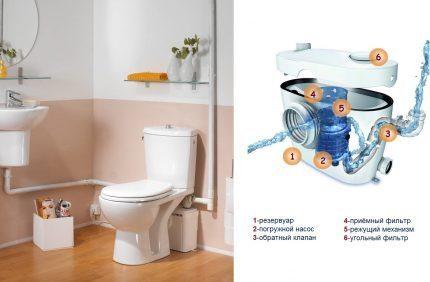
Household sewage pump is a direct analogue of the pump in the washing machine, only set it for toilets, tubs and sinks
Such equipment is quite expensive, but it allows you to mount the plumbing in any convenient place. The pump, when filling the plumbing tank pump out raw sewage into the riser, even if the objection to it is tilted up.
Such systems practically do not require maintenance. Structurally, they contain a cumulative self-cleaning tank. And to eliminate the appearance of unpleasant smell, is provided inside the canister. Special skills to connect this pump is not required, it is necessary only not to forget from time to time to wash the drive.
Which is better: submersible vs surface
Under the same pressure at the output of the submersible sewage pump consumes less power than its exterior self-priming counterpart. The first is simply not having to spend energy on suction drains for removal from the bottom of the tank to the working chamber. All the power spent on the creation of pressure in the pressure line.
The pump is completely submerged in the wastewater, noise less than settled on the surface. Water absorbs a great part of the sounds produced by the motor and rotating working elements of the pump.

Surface equipment is more noisy than immersed in a sewage tank, which is cooled by the liquid around
Ease of use the palm can be given a surface model, but only if it is compact and portable. Plus, the correctness of its operation can be controlled simply by the noise. If an incorrect motor operation appear unusual sounds, immediately pointing to the problem.
Under other equal parameters and additional surface equipment pumping station is almost always cheaper submersible sewage pump. Of course, much depends on the manufacturer and competition in a particular region. However, immersed in the filth of the technique, by definition, smarter and harder, which explains its higher price.
How to properly select pumping equipment
Choosing a pump for pumping sewage, it is necessary to pay attention to a variety specified in its technical data sheet. For example, the performance options will help to estimate the time for which you can be emptied the tank with the drains. Than the figure above, the more the unit will be able to pump fluid, but the more it consumes energy to do this. There are many other nuances.
The first factor is the maximum head lift height of
The rate of pressure determines the height to which the sewage pump to lift the effluent in the pressure line. But it is important to understand that in addition to vertical there is also the horizontal area of the outlet pipe. Simplistically, to calculate this parameter, the horizontal distance is divided by ten and end to the meter vertically from the pump to the rim of the container.
However, this calculation is very simplified, if you do everything by the rules, then you need to consider:
The second factor is the operating temperature
All pumping equipment for domestic sewage is divided into two categories:
For cold system – with operating temperatures up to 450C.
For hot system – with operating temperature up to 900C
If the sewer system is drained only cold water, it is best to take the first option, which is cheaper. In most cases, these are the pumps installed in the cottages. In fact, the boiling water in the sewage system of private houses can only be reached in case of emergency discharges from the heating system.
The third factor is the existence of automatics
To control the operation of a sewage pump by hand, constantly turning on and off it is problematic. You will need to be all near the equipment. Much better if the pumping equipment has:
Float – defines the level of effluent in the accumulator to start and stop the equipment.
The thermal relay is triggered when the critical temperature rise of the electric motor to shut it off before overheating.
To reduce the likelihood of clogging sewage pump with built-in grinder, some manufacturers provide self-cleaning of the cutting mechanism. This allows to increase the periods of operation of the unit without interruptions and stoppages for maintenance. Spontaneously running cleaning guarantees reduce the likelihood of overheating of the actuator.

From the structure of the impeller of the grinder directly determines the extent of grinding occurring in the effluent of waste – knives it is higher than the cutting edge
The fourth factor is the power supply and case material
To power the various models of sewage pumps from single-phase and three-phase mains. The first option is cheaper and more preferable in the conditions of Russian reality, so if you have problems with tension can be plugged into a surge protector or just connect a portable generator.
For three-phase pumping equipment will have to buy additional control panels, to protect him from a warp of phases in the electrical network. And that's extra money and complexity in the connection.
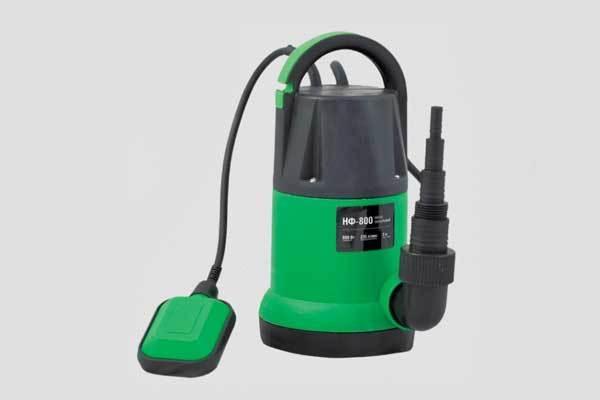
Compromise between cost and reliability can be considered equipment with plastic housing, but the metal work items
The most reliable for pumping wastewater sewage system are the pumps, which both the housing and the working part is made of metal. It may be cast iron or stainless steel. Cheaper plastic counterparts, but in the conditions of aggressive environment they will last without repair less. published
Source: sovet-ingenera.com/kanaliz/kanal-nasos/kanalizacionnye-nasosy.html
The hydraulic pump in a forced sewer system
To correctly select a pump, you need to understand in all its modifications and to consider many factors.
Most sewers are designed so that the water in it was moving by gravity. But not always a local septic tank or entry into the centralized sewage system is located below the sewer piping and all plumbing devices in the house. And up, the waste water itself can not rise, it is necessary to “force” her pump.
Pumping equipment is when because of terrain or other characteristics of surrounding area outside drainage pipe does not work to put the desired slant. It is also possible with the completion or remodeling of the building. Changes the configuration of the inner pipelines and the amount of waste, independently of the second can not be removed from residential buildings.

The task of the pump forced sanitation to pump out the wastewater and to encourage them to move to a street collector, which is above the cumulative or treatment plant
The most popular variant of the device of the sewer with forced pumping of wastewater provides a device in the basement of the cottage of intermediate storage. As it is filling to the brim the pump is activated, pumping out liquid on the street for further treatment or export. But you can set up a compact pumping unit, included only when the sink drains. However, when it breaks the house will actually remain without sanitation.
Compared to gravity system pressure pumps provides a number of advantages:
Reduced frequency of cleaning of pipelines, as intense movement of wastewater contributes to their self-cleaning.
Sanitary and household appliances with connection to the sewage system is already can be put anywhere without regard for the formation of the slope in the direction of release of sewer, and then drive, or septic tank.
According to the technical regulations (SNiP No. 2.04.03-85), the smallest diameter pipe outside the mainline pressure sewer network was adopted by 150 mm, when arranged obsessively effluent discharge. This network transporting storm water run-off together with household black and grey. Domestic gravity fed systems arranged from the Troyes of the same size.
If human waste water are discharged separately, the diameter of the pipeline is taken is filled to 0.7 of its maximum height. This distance is necessary for ventilation and the possibility of the withdrawal of an unpleasant and explosive gazoobrazovania. The size of the sewer must be considered when choosing a pump to accurately select the unit for the upcoming load.
The forced system is volatile, and costs a lot of money, rather than gravity. If the family is small, the drive is filled immediately, sewage pump could be sufficient from time to time. But for large volume of waste water pumping equipment needs to work almost constantly. In this case, when a power outage can cause serious problems.
A large part of the cost to repair cannot recapture due to the use of cheaper and thin tubes and reduce the cost of their installation. But after the installation of this equipment requires constant maintenance, which requires some money. And if we add another source of power in case of an accident at the power grids, the gain is obtained is zero.

For the device forced the sewer system of a small private house or garden, diverting the mixture of black and grey wastewater, suitable for holding the pump. He will cope with pumping water combined sewer
If it is possible to do with gravity sewer option, you should do it. Pressure system with sewage pump for viscous and contaminated liquids should be chosen only as a last resort. And special attention should be paid to the proper selection of pumping equipment.
Types of pumps for pressure sewer
The most important thing in the selection of pumping equipment for pumping of sewage is clearly separate it from the drainage and water lifting for drinking wells of varieties of these devices. The last two options are exclusively designed for pumping clean or with a fine mist of water. Ingestion of more solid faeces or garbage, they simply break.

Lineup fecal pumps is quite extensive, but the diversity of this equipment can be divided into three classes: submersible, semi-submersible and external
Special sewage pump designed specifically for pumping sewage with all the household waste that fall to the drain from sinks, toilets, dishwashers and washing machines. The most optimal choice here is the pumping equipment with the chopper that grinds all waste before it goes inside the pump drains the unit.
In General, faecal pumps are used for:
- pumping of sewage to the sewer network with a forced current;
- pumping sludge from raking, septic tanks and pits street toilets;
- pumping water out of basements and cellars;
- cleaning of pipes and structures sewer from muddy sediment.
Type No. 1: Submersible device
This kind of pumps are all immersed directly in the sewers. All the elements of their design are made of stainless steel or of cast iron to get in contact with the active and aggressive environment does not emerge immediately from the system.

Submersible sewage pump is installed on the tank bottom, or suspended just above him on the rope
Usually, this pumping equipment is operated automatically. When filling the tank drains with them rises the float which at a certain level of liquid includes the installation of pumping. As soon as the container is emptied, the pump float switch is turned off. Work “dry” at the same time is practically impossible.
Submersible models are preferred due to their high performance and equipment of the chipper. Last macerator grinds waste to any large size that do not pose a threat to pumping equipment. Almost all sewage submersible pumps come with a built-in grinder, rotary knives which can easily cope with paper, fibrous items and solids.
Type No. 2: Surface model
Surface pumps for pumping sewage are installed next to the manifold, collect and redirect runoff, or most convenient to place it into the observation well. This so-called dry cut. They are often also referred to as pumping units forced the sewer system due to the presence of several collect together the individual parts.
Polluted runoff in this case are absorbed via connected to the pump unit hose that goes down to the bottom of the tank. If you choose this model, it is necessary special attention should be paid to the parameters of the suction depth specified by the manufacturer. Usually up to 8-10 meters deep, he simply cannot lift drains out of the reservoir. This should take into account not only the height of the receptacle, and the distance from it to the pump.

Surface pumping equipment is easier to service, it can be quickly dismantled and washed in the utility room
Low-power surface pump to operate in forced sanitation is a compact unit that is simply mounted near the drive drains. Installation of more powerful models are produced on a specially prepared place with reliable fixation of the device to the floor.
It is extremely important when installing the outdoor pump to worry about its protection from moisture. In contrast to the submersible analogue it is fundamentally not designed to work in a wet environment. His case has minimal protection from water, in contact with which the inside of the closure may occur.
The surface pump is inexpensive and simple to operate, but enough of Shumen. For installation in heated basement or utility room it is better to take it. However, if you turn on the equipment it will be necessary only from time to time to pump the septic tank, it is better to prefer submerged.
Type No. 3: the semi-Submersible installation
These models are a kind of intermediate option between the submersible and the external view of the pump equipment. They have the motor installed next to the container above the water and the working chamber is immersed in the sewage. Between these two parts of a single installation contact a rotating shaft.
Installation of submersible pump can be done on:
- floating on the wastewater surface of the pillow;
- the platform next to the tank;
- the wall of the tank.

Due to the design features of submersible pumps are rarely used in a domestic environment, it is more a variant for industrial applications and large pumping stations
Type # 4: Small units for pumping drains from the plumbing
Under the sewer pump to toilet or basin means small machines that are installed near the fixtures. Effluent from the first last fall in a small tank, and it is discharged into the General sewer system.

Household sewage pump is a direct analogue of the pump in the washing machine, only set it for toilets, tubs and sinks
Such equipment is quite expensive, but it allows you to mount the plumbing in any convenient place. The pump, when filling the plumbing tank pump out raw sewage into the riser, even if the objection to it is tilted up.
Such systems practically do not require maintenance. Structurally, they contain a cumulative self-cleaning tank. And to eliminate the appearance of unpleasant smell, is provided inside the canister. Special skills to connect this pump is not required, it is necessary only not to forget from time to time to wash the drive.
Which is better: submersible vs surface
Under the same pressure at the output of the submersible sewage pump consumes less power than its exterior self-priming counterpart. The first is simply not having to spend energy on suction drains for removal from the bottom of the tank to the working chamber. All the power spent on the creation of pressure in the pressure line.
The pump is completely submerged in the wastewater, noise less than settled on the surface. Water absorbs a great part of the sounds produced by the motor and rotating working elements of the pump.

Surface equipment is more noisy than immersed in a sewage tank, which is cooled by the liquid around
Ease of use the palm can be given a surface model, but only if it is compact and portable. Plus, the correctness of its operation can be controlled simply by the noise. If an incorrect motor operation appear unusual sounds, immediately pointing to the problem.
Under other equal parameters and additional surface equipment pumping station is almost always cheaper submersible sewage pump. Of course, much depends on the manufacturer and competition in a particular region. However, immersed in the filth of the technique, by definition, smarter and harder, which explains its higher price.
How to properly select pumping equipment
Choosing a pump for pumping sewage, it is necessary to pay attention to a variety specified in its technical data sheet. For example, the performance options will help to estimate the time for which you can be emptied the tank with the drains. Than the figure above, the more the unit will be able to pump fluid, but the more it consumes energy to do this. There are many other nuances.
The first factor is the maximum head lift height of
The rate of pressure determines the height to which the sewage pump to lift the effluent in the pressure line. But it is important to understand that in addition to vertical there is also the horizontal area of the outlet pipe. Simplistically, to calculate this parameter, the horizontal distance is divided by ten and end to the meter vertically from the pump to the rim of the container.
However, this calculation is very simplified, if you do everything by the rules, then you need to consider:
- the composition and temperature of the liquid and the amount of impurities in it;
- the level of roughness of all pipes (the material of their manufacture);
- pressure loss during the passage of the stop valve;
- the diameter of the pipe;
- atmospheric pressure;
- the speed of movement of drains and much more.
The second factor is the operating temperature
All pumping equipment for domestic sewage is divided into two categories:
For cold system – with operating temperatures up to 450C.
For hot system – with operating temperature up to 900C
If the sewer system is drained only cold water, it is best to take the first option, which is cheaper. In most cases, these are the pumps installed in the cottages. In fact, the boiling water in the sewage system of private houses can only be reached in case of emergency discharges from the heating system.
The third factor is the existence of automatics
To control the operation of a sewage pump by hand, constantly turning on and off it is problematic. You will need to be all near the equipment. Much better if the pumping equipment has:
Float – defines the level of effluent in the accumulator to start and stop the equipment.
The thermal relay is triggered when the critical temperature rise of the electric motor to shut it off before overheating.
To reduce the likelihood of clogging sewage pump with built-in grinder, some manufacturers provide self-cleaning of the cutting mechanism. This allows to increase the periods of operation of the unit without interruptions and stoppages for maintenance. Spontaneously running cleaning guarantees reduce the likelihood of overheating of the actuator.

From the structure of the impeller of the grinder directly determines the extent of grinding occurring in the effluent of waste – knives it is higher than the cutting edge
The fourth factor is the power supply and case material
To power the various models of sewage pumps from single-phase and three-phase mains. The first option is cheaper and more preferable in the conditions of Russian reality, so if you have problems with tension can be plugged into a surge protector or just connect a portable generator.
For three-phase pumping equipment will have to buy additional control panels, to protect him from a warp of phases in the electrical network. And that's extra money and complexity in the connection.

Compromise between cost and reliability can be considered equipment with plastic housing, but the metal work items
The most reliable for pumping wastewater sewage system are the pumps, which both the housing and the working part is made of metal. It may be cast iron or stainless steel. Cheaper plastic counterparts, but in the conditions of aggressive environment they will last without repair less. published
Source: sovet-ingenera.com/kanaliz/kanal-nasos/kanalizacionnye-nasosy.html


